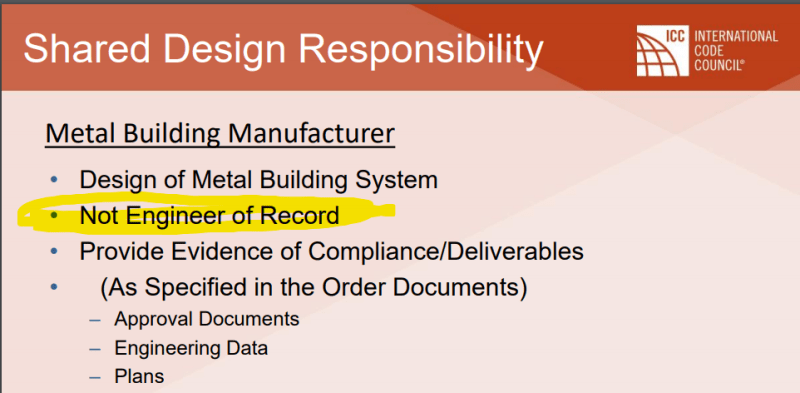Question: does the Engineer of Record for a project have a duty to respond to comments from the AHJ during plan review and permitting?
I'm NOT referring to contractual obligations - this is more of an ethical/statutory thing. State laws being state laws, it's Virginia in case anyone has any specific knowledge, but generally around the US would be good to know, too.
My specific case: had a client ask me to take a look at a prefab building. The AHJ won't give him a permit for it because the engineered drawings supplied by the manufacturer and the manufacturer's engineer don't have all of the information mandated by the code on them. The EOR has essentially told the owner of this unpermittable building that what's on the drawing is all they get.
This is completely foreign to me - I've always assumed that I was required to carry a design at least as far as responding to review questions/comments and have carried out my business that way. Once it gets approval (the AHJ essentially saying yes, the building is code compliant), then matters change and it depends on whether or not I have a contract for CA, etc. But I always thought that I had to at least go along with the review process. Am I mistaken? Is there no requirement? I'm not planning to change how I do things, but I don't want to tell my client that the other engineer is required to do something he's really not. And the flip side of that, I'd love to tell my client that the drawings are missing X Y and Z and, by the way, the other engineer is required by such-and-such to provide it. Then I don't have to get my hands too dirty in proving this building works...
I'm NOT referring to contractual obligations - this is more of an ethical/statutory thing. State laws being state laws, it's Virginia in case anyone has any specific knowledge, but generally around the US would be good to know, too.
My specific case: had a client ask me to take a look at a prefab building. The AHJ won't give him a permit for it because the engineered drawings supplied by the manufacturer and the manufacturer's engineer don't have all of the information mandated by the code on them. The EOR has essentially told the owner of this unpermittable building that what's on the drawing is all they get.
This is completely foreign to me - I've always assumed that I was required to carry a design at least as far as responding to review questions/comments and have carried out my business that way. Once it gets approval (the AHJ essentially saying yes, the building is code compliant), then matters change and it depends on whether or not I have a contract for CA, etc. But I always thought that I had to at least go along with the review process. Am I mistaken? Is there no requirement? I'm not planning to change how I do things, but I don't want to tell my client that the other engineer is required to do something he's really not. And the flip side of that, I'd love to tell my client that the drawings are missing X Y and Z and, by the way, the other engineer is required by such-and-such to provide it. Then I don't have to get my hands too dirty in proving this building works...

![[pipe] [pipe] [pipe]](/data/assets/smilies/pipe.gif)
